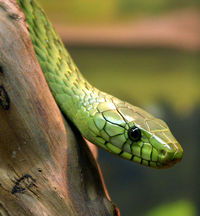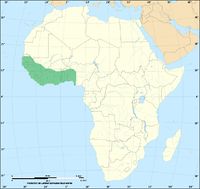Western green mamba
| Western green mamba | ||||||||||||||||||||
|---|---|---|---|---|---|---|---|---|---|---|---|---|---|---|---|---|---|---|---|---|
 Western green mamba
| ||||||||||||||||||||
| Scientific classification | ||||||||||||||||||||
| ||||||||||||||||||||
| Binomial name | ||||||||||||||||||||
| Dendroaspis viridis (Hallowell, 1844)[[1][2] | ||||||||||||||||||||
 Distribution of the Western green mamba
| ||||||||||||||||||||
| Synonyms | ||||||||||||||||||||
|
The Western green mamba (Dendroaspis viridis), also called the West African green mamba is a species of highly venomous snake native to West Africa and belonging to the Elapidae family. It is an active, arboreal snake feeding almost exclusively on birds and small mammals. It is a shy species that's rarely ever seen. It occurs on the coastal regions of western Africa from Senegal to southwestern Nigeria. Like other mamba species, it is highly venomous and a single bite can easily kill more than one grown adult human.
Etymology
The Western green mamba was first described by American herpetologist Edward Hallowell in 1844.[3] The genus name is derived from the Ancient Greek word - Dendroaspis meaning "tree asp" (dendro is "tree", while aspis is "asp" which is understood to mean a "venomous snake") and viridis comes from the Latin term virid and means "green".
Description
This species is a relatively large in length, slightly compressed, very slender bodied snake with a long tapering tail. The head is narrow and elongate, with a distinct canthus and slightly distinct from the neck. The neck may be flattened when the snake is aroused, but there is no hood. The eyes are medium in size with round pupils and yellow brown iris. Dorsal scales are oblique, smooth, and exceptionally large and narrow (each dorsal, except the one bordering the ventral row, is equivalent to 2 ventrals in length). The average length of this species is between 1.4 m (4.59 ft) and 2.1 m (6.89 ft), but some specimens have been known to grow longer than 2.5 m (8.2 ft) long. The tail accounts for 20-25% of the total body length. Western green mambas can be variable in color. Most specimens are greenish-yellow, olive green, emerald green, while some specimens are sky blue or yellow. The scales over the body have black edging. The tail is yellow with black edging around the scales which gives it a sort of netting. The dorsal scales of this species are very big for an elapid. The skin between the scales is also black and visible. The ventrals are pale green, yellow or blueish grey.[4][5]
Scalation
Dorsal scales at midbody 13, ventrals are 211-225, subcaudals are 107-120 (paired), anal plate is divided, upper labials 7-9, lower labials 8-10, preoculars 3, postoculars 3-4, temporales 2+1 variable.[6]
Distribution and habitat
Geographical distribution
The Western green mamba is native to West Africa and it can be found in Senegal, the Gambia, Guinea-Bissau, Guinea, Sierra Leone, Liberia, Côte d'Ivoire (Ivory Coast), Ghana, Togo, Benin and southwestern Nigeria. It can also be found in the southwestern tip of Mali, along the border with Côte d’Ivoire and Guinea. Its range from Ghana to Nigeria is fragmented.
Habitat
Western green mambas live mainly in the coastal tropical rainforest, thicket, and woodland regions of western Africa. Although mainly found in dense and closed forests, these snakes can persist in areas where the tree cover has been removed, providing that sufficient hedges and thicket remain. In areas where there is very severe encroachment on their natural habitat or areas where vegetation or trees have been destroyed, these snakes will go into suitably vegetated city suburbs and towns often dwelling in the thickets of bushes or atop lush trees in parks and other well vegetated areas.[5][6]
Behaviour and ecology
Behaviour
This species is mostly diurnal, but may be active at night as well. It is an arboreal snake, but it does commonly go to the ground. In fact, it is equally at home hunting and feeding on prey on the ground or in trees. When it wants to sleep it seeks out tree branches that offer dense cover. It is a very quick, extremely agile, alert, and very aggressive and nervous snake. When confronted it will quickly attempt to escape (usually up a tree if possible) and avoid any sort of confrontation. If cornered, the Western green mamba is highly dangerous and will show a fearsome display of aggression, loudly hissing and striking repeatedly.[5][6]
Diet
The western green mamba's natural prey consists mainly of birds and small mammals, including rodents such as mice, rats, and squirrels. Other mammals include bats, tree pangolins, and shrews. They also feed on lizards, frogs, and bird eggs. This snake actively pursues its prey, striking rapidly and often until the prey succumbs to the venom.[5][7]
Predators
The western green mamba has no natural predators, but humans and birds of prey are this snake's main threat.[3][7]
Venom
The western green mamba's venom is similar to other members of the mamba (Dendroaspis) family, but differs from other mamba's in toxicity or even the mixture of toxins in the venom at times. The venom consists mainly of neurotoxins, cardiotoxins,[8] and fasciculins.[5] The subcutaneous LD50 for this species is 0.7 mg/kg[9][10] and the average venom yield per bite is approximately 100 mg. Human fatalities as a result of bites from this species are rare due to the fact that this species does not often cross paths with humans, but bites have occurred and many of the recorded bites have been fatal.[8] The mortality rate of untreated bites is not exactly known, but it is thought to be quite high.[5] When bitten, symptoms rapidly begin to manifest, usually within the first 15 minutes or less.[8] Common symptoms of a bite from a western green mamba include local pain and swelling, although uncommon, local necrosis can be moderate, ataxia, headache, drowsiness, difficulty breathing, vertigo, hypotension (low blood pressure), diarrhea, dizziness, and paralysis.[8] Left untreated, new and more severe symptoms begin to manifest. All symptoms worsen and the victim eventually dies due to suffocation resulting from paralysis of the respiratory muscles. Depending on the nature and severity of a bite, death can occur in as fast as an hour but usually it takes 2-4 hours before an untreated victim dies.[8][7]
Cited references
- ↑ Dendroaspis viridis (TSN 700484) at Integrated Taxonomic Information System. Accessed 6 June 2012.
- ↑ Dendroaspis viridis (HALLOWELL, 1844) at The Reptile Database. Accessed 6 June 2012.
- ↑ 3.0 3.1 Hallowell, E. 1844. Description of new species of African reptiles. Proc. Acad. Nat. Sci. Philad. 1844: 169-172
- ↑ Spawls, Stephen. Branch, Bill. 1995. The Dangerous Snakes of Africa: Natural History, Species Directory, Venoms and Snakebite. Oriental Press, Ralph Curtis Books. 49-51 pp. ISBN 0-88359-029-8.
- ↑ 5.0 5.1 5.2 5.3 5.4 5.5 Western green mamba: General Details at Clinical Toxinology. Accessed 6 June 2012.
- ↑ 6.0 6.1 6.2 Western green mamba at Devenomized. Accessed 6 June 2012.
- ↑ 7.0 7.1 7.2 (1987) Mamba's. USA: Rourke Enterprises. ISBN 0-86592-960-2.
- ↑ 8.0 8.1 8.2 8.3 8.4 Davidson, Terence. IMMEDIATE FIRST AID. University of California, San Diego. Retrieved on 6 June 2012.
- ↑ Brown JH (1973) Toxicology and Pharmacology of Venoms from Poisonous Snakes. Springfield, Illinois: Charles C. Thomas. 184 pp. LCCCN 73-229. ISBN 0-398-02808-7
- ↑ Fry, Dr. Bryan Grieg. LD50 Menu. Australian Venom Research Unit. University of Queensland. Retrieved on 6 June 2012.